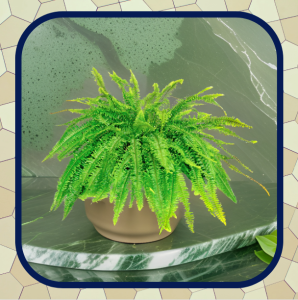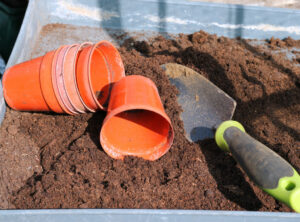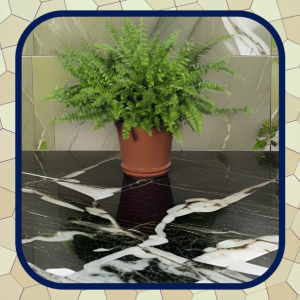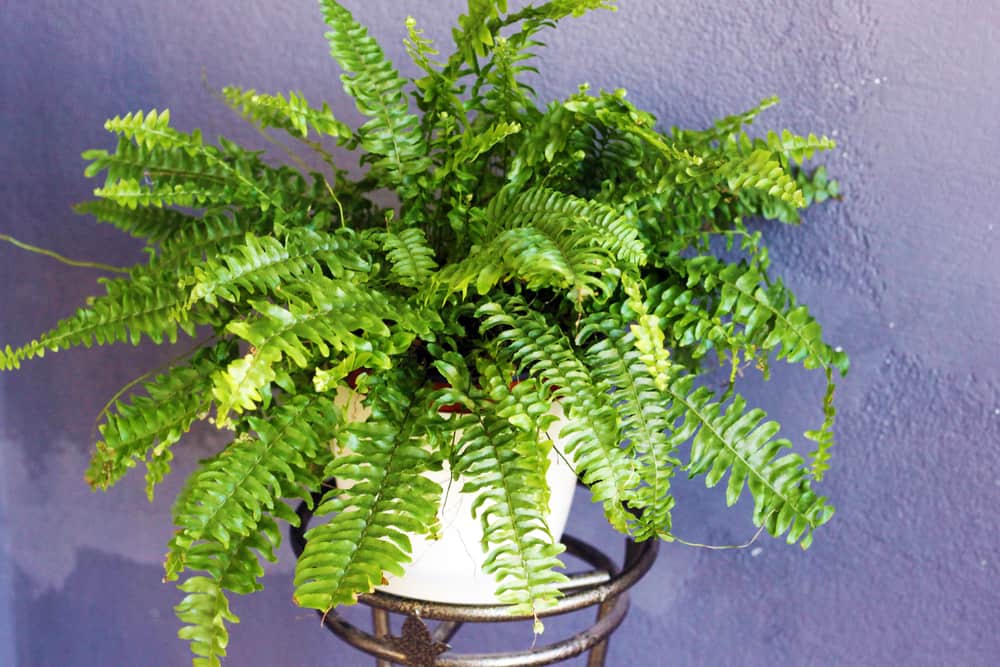HousePlantJoy is supported by our audience. When you purchase through one of our links, we may earn a small affiliate commission. As an Amazon Associate I earn from qualifying purchases. Your cost is not affected.
==================
How to Re-Pot a Boston Fern is a comprehensive guide to maintaining the vitality of one of the most versatile outdoor plants. Whether adorning your living room, gracing a wrap-around porch, or suspended in elegant hanging baskets, the Boston Fern’s beautiful, long, lacy fronds can thrive as outdoor ferns. Knowing the nuances of when and how to re-pot a Boston Fern is crucial for sustaining its hardy and low-maintenance nature, making it a perfect choice for those who prefer to plant outdoors. With the right care, these lush ferns can flourish in various settings, creating a captivating visual appeal when paired with other flowering annuals. This guide not only provides insights into the benefits of repotting Boston Fern, but also emphasizes the importance of keeping the soil evenly moist to ensure optimal growth and resilience against adverse conditions.
How to Re-Pot a Boston Fern
The Boston fern is one of the most versatile plants. With their beautiful, long, lacy fronds, you can quickly grow them inside the living room, on a wrap-around porch, or in hanging baskets. But do you know how to re-pot a Boston Fern? Additionally, it would be best to learn when to re-pot a Boston Fern.
Boston Ferns in General
Boston Fern is one of the most popular and versatile houseplants that doesn’t demand a specific environment and requires minimal care. You can plant them indoors all year round and outside your home during the warm seasons. In short, they are hardy and low-maintenance houseplants.
They look beautiful in the hanging baskets, sitting on a table, or planted in a garden to create a border. Besides that, you can also plant them in the ground directly. Because of their versatility, you can pair them with flowering annuals regardless of color to make a charming focal point in combination planting.
However, since the houseplant is a vigorous grower, you must re-pot Boston ferns every two or three years. This sturdy, independent houseplant can easily tolerate re-potting when it begins to outgrow. Below, I will explain how and when to re-pot Boston ferns and valuable tips to keep your houseplant thriving.
Benefits of Repotting Boston Fern
Repotting Boston fern is easy and helps you to keep your houseplant thriving. Boston ferns tend to get dry during winter, and you want to avoid having them sit in the water like any other fern. Repotting Boston fern is the best way to keep your houseplant away from other invasive plants that could damage it. Moreover, it will also keep your houseplant from becoming stressed because of the poor conditions.
Another benefit of Boston ferns is their adaptability. They are among the most adaptable houseplants regarding where to place them. For example, if you have planted a Boston fern in a small pot, it will perform well even if you re-pot Boston fern into another enclosed space. It means re-potting Boston fern also helps you to keep your houseplant away from harsh weather elements.
When to Re-pot a Boston Fern
Some vigorous growing ferns require re-potting more often when they begin outgrowing. Similarly, Boston ferns require re-potting at least two to three years. However, they show plenty of signs indicating that your houseplant requires a broader, more prominent space to grow.
For instance, if your fern is too big and the container is small, you will spot Boston fern’s roots growing through the container’s drainage holes. Another sign that indicates to re-pot Boston fern is the soil drying more quickly than it should be. Moreover, regardless of fertilizing the fern, the decreased growth rate is another sign that indicates that it’s time to re-pot Boston fern.
In other cases, water runs straight through the drainage holes when the container is packed with the plant roots, causing the plant to wilt quickly. Furthermore, your Boston fern can crack through the container if it is root-bound. So, it is good to re-pot Boston Fern before this happens.
What Should You Consider Before Repotting Boston Fern?
Though you can re-pot Boston fern into a more extensive and spacious container when it begins to outgrow, you should know that it can damage your houseplant. This is because a larger container with a more extensive potting mixture takes more water than your houseplant needs. It results in developing root rot, which can kill your plant.
So, it is best to re-pot Boston fern into a container only a few inches larger than the current container. In this regard, you can use any container, but ensure it has drainage holes in the bottom. It is recommended to use plastic containers, as they keep the soil moist for longer than terracotta.
How to Re-pot Boston Fern
Finally, water it more frequently before you re-pot Boston fern and wait a few days. It will keep the soil moist and simplify the Boston fern re-potting process. As mentioned above, ensure you have a new container that is only a few inches larger (at least two or three inches) than the current container. Avoid planting your Boston fern in a pot with a larger diameter so the soil doesn’t store more water than your plant needs.
Now, take the fresh potting soil and fill your new container about two to three inches. Carefully remove the houseplant from its container and place it in the center of the new pot. Now, add the potting soil around the plant. Adjust the potting soil in the bottom of the pot. Ensure you planted your Boston fern at the same depth it was planted before in the previous pot. Avoid planting your houseplant too profoundly, as it can cause root rot and kill your plant.
Once you have re-potted the Boston fern, water it thoroughly and place it where it doesn’t get direct light for a few days. Then, once it starts thriving in the new container, you can move it to its original location and resume regular maintenance.
How to Care Boston Fern About Repotting
Since you have re-potted Boston fern to its new pot, you have to keep the soil moist to keep it thriving. In this regard, could you water it with lukewarm water until it drips through the drainage holes? After that, let your houseplant drain thoroughly. Also, ensure that you do not fertilize your newly re-potted Boston fern for at least six months.
Moreover, after re-potting Boston fern, remember that it does well in deep or partial shade. So, make sure to keep it from direct sunlight. To avoid root rot, make sure the soil is properly draining. Once your houseplant is established in its new pot, fertilize no more than once a month.
What to Do If Boston Fern Freezes After Repotting?
If your Boston fern is exposed to freeze for longer, it can damage the plant roots. In contrast, a brief cold can harm the fronds. You cannot save every frozen fern, but if your houseplant roots are safe, your plant can survive. With proper care and maintenance, you can speed up the recovery. Here is what you should do if your Boston fern freezes after re-potting.
Move the Plant
Right after your Boston fern freezes, move it to a frost-free location to minimize the damage. However, keeping the damaged ferns in the cold rather than in a hot place is recommended. Watering can also help to reduce the damage by hydrating the roots. If you notice that the soil is frozen, pour the water until it starts dripping. Once the water drains completely, pour water again until the soil thaws. Moreover, keep the damaged ferns out of direct light to avoid further damage.
Evaluate the Damage
If, after re-potting Boston fern, only the fronds are frozen, your plant can recover quickly. However, if the freeze damaged your plant’s roots, it has few chances to recover. Therefore, you must evaluate the frost damage after exposing your plant to prolonged freeze. If you notice mushy black roots around the edges, they are damaged by frost. Therefore, you can cut them to stop further damage. Moreover, if you notice black roots all the way, your plant won’t survive.
Restore Your Plant
After cold damage to the fronds of your Boston fern, wait to prune until the frost season passes. You can still prune your plant in mild coastal areas in late winter. Make sure to cut the damaged fronds carefully so you don’t damage new shoots.
Protection Against Frost
Boston ferns planted in containers are less likely to survive in cold temperatures than those growing in the soil. Container plants exposed to temperature fluctuations freeze more rapidly. You can avoid the damage by re-potting Boston fern planted in a container to a greenhouse before the frost hits. However, if your fern is too big and the container is too heavy to move, you can cover it with blankets or bubble wrap to prevent frost damage.
Revitalizing Your Outdoor Oasis: Unveiling the Elegance of Boston Ferns
Enhancing the allure of your garden, Boston Ferns stand out as exceptional outdoor ferns, offering unmatched elegance in various settings. When choosing to plant outdoors, their adaptability shines through, effortlessly complementing the surroundings. To further elevate their resilience, occasional repotting of Boston Ferns is essential, ensuring they maintain their hardy nature. As you embrace this process, prioritize a container only a few inches larger to avoid overwhelming the plant. Additionally, a key aspect lies in maintaining the soil evenly moist, a practice vital for the sustained vibrancy of these outdoor marvels. Embrace the unique charm of Boston Ferns, turning your outdoor space into a haven of lush greenery.
Wrapping Up
That is all about when and how to re-pot Boston fern. It is a popular houseplant that doesn’t care much about the environment. However, when you re-pot Boston fern, use a more extensive container, but no more than a few inches, and good commercial potting soil. Moreover, if your plant is too big and you do not want it to get any more significant, you can divide it into sections and then re-pot Boston fern.
Unleash your green thumb and become a master of Ginseng Ficus Bonsai (Ficus retusa) Care. Get started today to learn, grow, and nurture your Bonsai tree.
FAQs
What is the relationship between the lemon button fern and the Boston fern?
The Boston fern (Nephrolepis exaltata), a close relative of the lemon button fern, shares many similarities regarding care and growth requirements. Both ferns belong to the Nephrolepis genus and exhibit comparable characteristics. Although they have different foliage appearances, they can thrive under similar conditions and care guidelines.
Like the lemon button fern, the Boston fern prefers indirect light and thrives in bright, filtered light environments. Direct sunlight should be avoided to prevent leaf burn. Both ferns also appreciate a consistently moist environment and high humidity levels. Regular misting, placing the pot on a tray of water and pebbles, or utilizing a humidifier can help maintain the desired humidity for Boston ferns, just as with lemon button ferns.
How does caring for a lemon button fern relate to caring for a Boston fern?
The care for lemon button fern plants is similar to caring for a Boston fern, another popular fern variety. Here’s how the care for these ferns connect:
- Lighting: Both lemon button ferns and Boston ferns prefer bright, indirect light. They thrive when placed near a window with filtered sunlight or provided with artificial fluorescent lighting.
- Temperature and Humidity: Lemon button ferns and Boston ferns have similar temperature preferences, thriving in moderate temperatures ranging between 60°F to 75°F (15°C to 24°C). They both appreciate high humidity levels as well. Consider using a humidifier or placing trays of water and pebbles near these ferns to increase humidity.
- Watering: Lemon button ferns and Boston ferns both require consistent moisture. Water them when the top inch of soil feels slightly dry, ensuring proper drainage to avoid overwatering and root rot.
- Soil: Lemon button ferns and Boston ferns benefit from well-draining potting soil. A mix of peat moss, perlite, and organic matter provides an ideal growing medium for both fern varieties.
- Fertilization: Both ferns can be fertilized with a balanced liquid fertilizer diluted to half strength every two to four weeks during the growing season. However, avoid fertilizing them during winter months.
- Pruning: Regular pruning benefits both lemon button ferns and Boston ferns. Trim any yellowing or brown fronds to maintain their appearance and remove dead or diseased leaves to promote healthy growth.
- Repotting: Lemon button ferns and Boston ferns may require repotting every one to two years. When repotting, choose slightly larger pots with fresh potting mix, giving the ferns room to grow and thrive.
By recognizing these similarities in lemon Boston and lemon button fern care, you can apply the knowledge gained from caring for a lemon button fern to care for a Boston fern, and vice versa.
Discover Houseplant Bliss!
Unlock a world of green wonders and cultivate your passion for houseplants with Houseplant Joy! ? Connect with a vibrant community, explore engaging content, and dive into insightful product reviews on our social media platforms:
? Facebook: HouseplantJoyBlog
? Instagram: HouseplantJoy20
? Pinterest: HouseplantJoy
? Twitter: HouseplantJoy
Join us on the journey to plant perfection! ? #HouseplantJoy #GreenLiving ?















